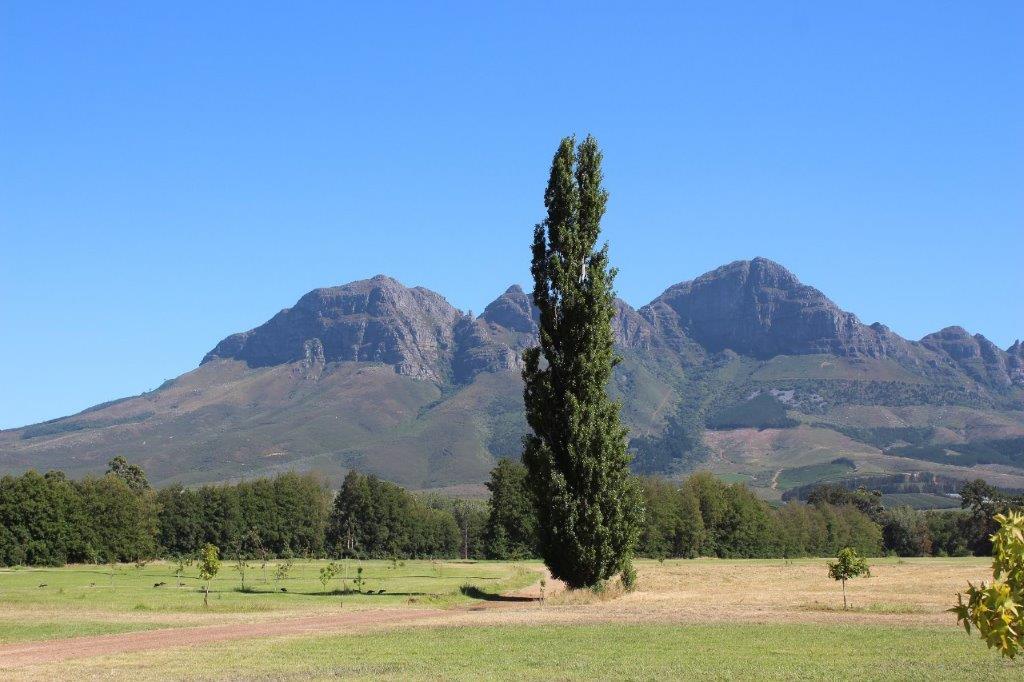Greening the future: Vergelegen wine estate unveils plans for vast arboretum
08:48:00Vergelegen, the 321-year-old Somerset West wine estate renowned for its 18 magnificent gardens, has unveiled plans for a vast 54 hectare botanical garden devoted to trees.
 |
| View of the Helderberg Mountains |
This arboretum will be created in a phased approach over ten years, during which about 7500 trees will be planted to create a beautiful, peaceful green sanctuary. A 3,5 km walkway surrounds the arboretum, allowing visitors access to various sections. Guests are already strolling around the vast area, which will offer a variety of footpaths and walking trails.
 |
| Concept plan for the Vergelegen arboretum |
This site was previously open ground and also home to an orchard, whose fruit trees had reached the end of their fruit-bearing lifespan. Instead of re-planting, the decision was taken to create the arboretum in this tranquil setting, which has beautiful views of the Hottentots Holland and Helderberg Mountains. The arboretum will form a transition between the cultivated and natural landscapes.
Leslie Naidoo, Vergelegen’s Commercial and Risk Manager, says: “Vergelegen management decided in 2016 to explore the creation of an arboretum in the north-east section of the property, with visitor access from the hospitality areas – the restaurants and wine tasting centre.
 |
| Commercial and Risk Manager Leslie Naidoo with a Quercus Robur |
“After conducting research on various international gardens such as the Royal Botanic Gardens in Kew and the Yorkshire Arboretum, we approached landscape architects to develop a concept. This evolved into our current plan.”
Trees reflect estate history
Three 45-meter-wide vistas in the form of a triangle form the core of the arboretum. The combined length of the vistas is 2,5km and each vista is lined with double row plantings of liquidambar, yellowwood and swamp cypress trees.
The vistas are intersected at intervals featuring four large semi-circles planted with avenues of trees of Dutch, Asian, English and French origin. These will reflect the layered history of the estate, which is a provincial heritage site. The estate is considered a showpiece of South African heritage and gardens, wine and hospitality, and the natural environment.
 |
| Quercus Robur planted in the Rosid area |
A wide range of trees from the Rosids (Cape Ash, White Stinkwood and Oaks), Asterids (Assegaai, Cape Holly and Rhododendrons), Magnolids (Tulip tree, Ginkgo and various Magnolia trees) and Conifers (Juniper, Deodara and Cypress) species will be planted together in groups to create a ‘treescape’.
Clearing and preparing the land started in 2017, while planting the Rosid section with 1216 trees began in 2019. Irrigation has been installed here and signage erected to inform visitors about the plans.
Scott Mpondo, who studied for his National Diploma in Horticulture at the Cape Peninsula University of Technology, has joined the Vergelegen gardening staff as Junior Horticulturist, tasked with assisting on the project.
 |
| Junior Horticulturist Scott Mpondo with a ginkgo tree at the start of the arboretum |
The next stage is sourcing and planting 1500 trees from the Asterid species. These are sourced from local nurseries and any rare specimens can be propagated.
Naidoo says this enormous undertaking is possible because the estate is self-sufficient in water, following the conclusion of the largest privately funded alien vegetation clearing and rehabilitation project in South Africa. This programme has unleashed abundant water resources, which are fed by the Hottentots Holland catchment area.
The intention is to create a unique horticultural, environmental and historic destination, based on four design principles of variety, intricacy, connection and quality.
 |
| North-south existing windbreak kept to protect the young trees |
Design principles
- Variety means incorporating recesses and projections, differently shaped and coloured trees, open meadows and groves, and contrasting light and shaded walks.
- Intricacy will ensure a sense of sanctuary, while unfolding scenes will surprise and delight visitors.
- Connection between the various elements in a landscape, with gradual transitions, will achieve a harmonious whole.
- Finally, the design principle of quality will ensure that the open space is enhanced with an excellent, sustainable design that future generations will enjoy.
 |
| Vista of Liquidambar trees |
“The arboretum will form a natural addition as it will offer a remarkable collection of trees and plants from around the world, creating a peaceful oasis and also a living laboratory for conservation, research and education on international tree and plant biodiversity.”
Estate entry times
Currently Vergelegen is open from 08h30-17h00 Monday - Sunday (last entry is at 16h00). Please check the website vergelegen.co.za for opening hours during the lockdown.
Issued by: MEROPA COMMUNICATIONS
Pictures: SUPPLIED
© 2021 Herman Lintvelt - WineTourismZA













0 comments